Oh my goodness! Unless you are a Tree of Life developer,
you really shouldn't be here. This page is part of our beta test site, where we
develop new features for the ToL, often messing up a thing or two in the
process. Please visit the official version of this page, which is available
here.
Opisthoteuthis grimaldii: Description Continued
Roger Villanueva, Richard E. Young, and Michael Vecchione
- Arms
- The photograph below shows the arms of the mature male holotype. The proximal and distal fields of enlarged suckers are apparent.

Click on an image to view larger version & data in a new window
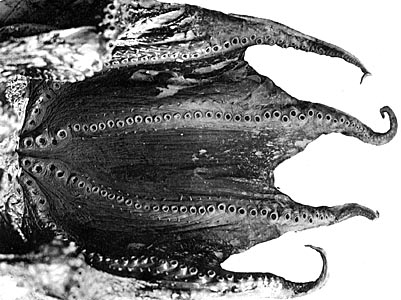
Figure. Oral view of the dorsal arms of O. grimaldii, holotype. Photograph from Joubin, 1920.
- Eyes
- Large, 45% of ML.
- Funnel
- Funnel organ with two, separate, elongate pads.
- Fins
- Without lobe near anterior insertion in preserved animals.
- Fin span ca. 4 times fin length.
- Gills
- Small, half-orange appearance.
- 7 or 8 primary lamellae per gill.
- Optic lobes and nerves
- Optic lobes kidney-shaped.
- Two or three optic nerve bundles pass through/by white body.

Click on an image to view larger version & data in a new window
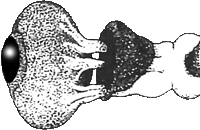
Figure. Ventral view of the eye, optic nerve tracts, white body and optic lobe of O. grimaldii. Drawing from Villanueva et al. (2002).
- Digestive tract
- Radula absent.
- Glandular-like area on buccal mass [presumably the posterior salivary glands].
- Esophagus dialated forming crop-like structure.
- Digestive gland bilobed.
- Intestine apparently slightly shorter than esophagus; forms S-shape.

Click on an image to view larger version & data in a new window
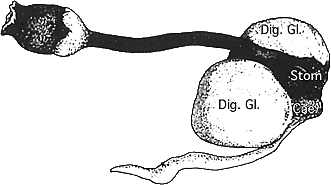
Figure. Lateral view of digestive tract of O. grimaldii. Drawing from Villanueva et al. (2002).
- Beaks
- Lower beak pointed; hood small; without folds or ridges on lateral walls.

Click on an image to view larger version & data in a new window
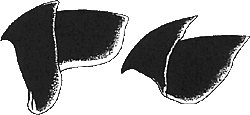
Figure. Lateral views of lower beak (left) and upper beak (right) of O. grimaldii. Drawing from Villanueva et al. (2002).
- Male reproductive system
- Accessory glands "2 and 3" approximately equal in size.
- Penis relatively long.
- Spermatophores oval, 1-2 mm long.

Click on an image to view larger version & data in a new window
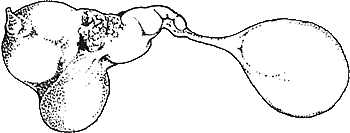
Figure. Reproductive tract of O. grimaldii, mature male, 42 mm ML. Drawing from Villanueva et al. (2002).
- Female reproductive system
- Unknown as females cannot be identified with certainty.
- Shell
- Stout with short, flaring lateral wings.
- Outer surface of saddle flat, without inrolling ridges; inner surface convex.
- Lateral wings taper to acute points.

Click on an image to view larger version & data in a new window
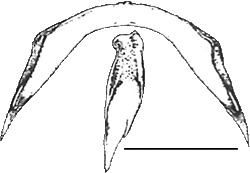
Figure. Dorsal (top) and lateral (bottom) views of the shell of O. grimaldii, mature male, 45 mm ML. Bar is 20 mm. Drawing from Villanueva et al. (2002).
- Pigmentation
- Octopod reddish-brown in preserved specimens.
- Areolae not observed in eastern Atlantic specimens.
- Measurements
- Measurements and counts can be found here.
Comments
Except for the first illustration, the above description is taken from Villanueva et al. (in press).
References
Joubin, L. 1920. Cephalopodes provenant des Campagnes de la Princesse Alice (1898-1910). 3e Serie. Monaco.
Villanueva, R., Collins, M., Sanchez, P. and N. Voss. 2002. Systematics, distribution and biology of the cirrate octopods of the genus Opisthoteuthis (Mollusca, Cephalopoda) in the Atlantic Ocean, with description of two new species. Bulletin of Marine Science 71(2):933-985.
About This Page
Drawings from Villanueva et al. (2002) printed with the Permission of the Bulletin of Marine Science.

Instituto de Ciencias del Mar (CSIC), Barcelona, Spain

University of Hawaii, Honolulu, HI, USA

National Museum of Natural History, Washington, D. C. , USA
Page copyright © 2003 , , and










 Go to quick links
Go to quick search
Go to navigation for this section of the ToL site
Go to detailed links for the ToL site
Go to quick links
Go to quick search
Go to navigation for this section of the ToL site
Go to detailed links for the ToL site